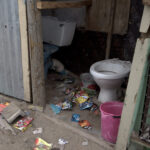The decrease has allowed the province to get rid of dangerous one-person ambulance crews, but many patients still wait hours for help.
Staff shortages have forced the Eastern Cape health department to almost halve the number of state ambulances on the road.
For years, state ambulances in the province have been scarce. The province has 447 ambulances — just over half the number that national standards require, according to guidelines quoted in a 2017 KwaZulu-Natal health department report. But today less than 250 of these vehicles are actually on the road, according to the Eastern Cape’s latest annual report. The document says that routine maintenance and a shortage of emergency medical workers are to blame for the cut.
With fewer operational ambulances, the department says it has however eliminated dangerous “one-man ambulance crews” — a term used to describe vehicles staffed only by a driver. With only one person at the helm, ambulances like these do not have additional medical staff to ensure patients are stabilised or treated on the often long rides between rural communities and healthcare facilities.
Internationally, it’s a “ubiquitous rule” that emergency response teams must have at least two members, researchers write in a 2018 article for the Journal of Emergency Medical Services.
They explain: “It’s based on the simple logic that during transport to a hospital, one member would need to operate the vehicle, while the other needs to attend the patient providing ongoing care.”
A 2015 South African Human Rights Commission investigation into the dire state of emergency medical services recommended the province stop deploying one-person ambulance crews. These crews’ existence was just one of the reasons the commission ultimately concluded that the Eastern Cape health department had violated patients’ Constitutional right to health by failing to provide adequate emergency care.
But activists and community members argue the government’s efforts do not go far enough to plug the gaps in emergency care that the commission pointed out nearly half a decade ago.
Strikes by healthcare workers shut down EMS services
Since 2016, the department’s EMS training college has produced 150 trained ambulance assistants — who work with paramedics to make sure patients are moved safely from where they got hurt into the emergency vehicle. As long as they’re supervised by a paramedic, ambulance assistants can also treat wounds and control bleeding.
But the course was stopped two years ago, says the department’s annual report.
In the last five years, only 30 paramedics have graduated with a degree in emergency medical care from Nelson Mandela University, the only school to offer paramedic training in the province.
Provincial emergency medical staff are also fed up about working conditions — including pay — and have engaged in periodic strikes since mid-January, says Thokozile Mtsolongo, a field researcher with public interest law organisation Section27.
Earlier this week, local paper the Graaff Reinet Advertiser reported that a strike among Metro Emergency Services brought ambulance services in that town to a standstill. The labour action also reportedly affected other towns including Makhanda, King Williamstown and Queenstown.
Mtsolongo says people who live in the province’s rural areas still wait hours to get an ambulance – that is if vehicles ever show up.
- Read more: When ambulances wouldn’t respond to calls in this community, one woman started her own EMS company
She explains: “The province’s solutions are superficial and do not do enough to address the lack of services.”
Manana, meanwhile, says his department is doing everything it can. He explains: “The budget is stretched as far as possible to ensure services are provided to all communities in the province.”
The Eastern Cape health department spends about 5% of its total budget on emergency medical services, its latest budget vote shows.
But even people lucky enough to live close to the province’s cities are not assured an ambulance ride to hospital in time.
In Mzamomhle, an informal settlement outside East London, one woman Bhekisisa spoke to in December said she waited six hours for an ambulance to arrive and take her son to the hospital after he was stabbed.
He died before the emergency vehicle arrived.
Mzamomhle is just a 20-minute drive from the ambulance dispatch in East London. Local pastor and community leader Ayanda Thunywa said the government is still failing the 10 786 people who live in the township and many more in the province.
He says: “We depend on the government, and they are letting us down. We are going to die. All of us.”
[Updated 17:10 pm 17 February 2020 This article was updated to reflect that Mzamomhle has 10 786 residents, according to Stats SA data, and not nearly 4 000 as was originally stated. The new figure was calculated using data from the 2011 census and the 2016 municipal elections.]
Joan van Dyk was a health journalist, senior health journalist and news editor at Bhekisisa between 2017 and 2023.





